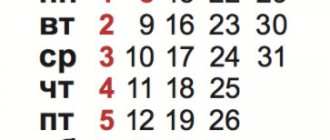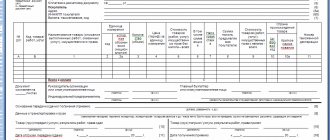Time sheets were approved in 2001 as primary documents mandatory for use. However, on January 1, 2013, an amendment came into force that abolishes the mandatory requirement for the use of unified forms. Now each organization can independently develop forms and forms, including all the details required by law.
Many enterprises continue to use unified forms T-12 and T-13, because independently developing forms is expensive, and failure to maintain them can lead to some undesirable consequences on the part of the tax service and the Social Insurance Fund.
Filling out timesheets requires the performer, who in the absence of the personnel officer is an accountant, to be attentive, know the symbols and the basic rules for entering data into the document. Otherwise, mistakes are inevitable that will lead to unfair distribution of the wage fund.
Time sheet: about the obligation to maintain
The obligation to take into account the time worked by employees is defined in Article 91 of the Labor Code of the Russian Federation. It applies to all employers, regardless of the form of business organization and its size. Microenterprises that have refused to draw up internal regulations on the basis of the provisions of Article 309.2 must also keep a timesheet. The reason is that the time sheet is not a labor law document, since it does not establish any standards. This is the primary accounting document, and it is mandatory for everyone.
It does not matter what wage system the employer has adopted – time-based or piece-rate. Maintaining employee time sheets is mandatory in any case. After all, recording hours worked is necessary not only for calculating wages, but also for monitoring the implementation of the work and rest regime.
The absence of a work time sheet may result in a fine under Part 1 of Article 5.27 of the Code of Administrative Offenses, as it is a violation of labor legislation.
Results
The Labor Code of the Russian Federation requires all employers to keep records of indicators reflecting employees’ attendance at work and the number of their working hours. For these purposes, a time sheet is used. The employer can conduct it manually or through automated solutions. In the first case, the T-12 form is used, in the second - the T-13 form. The exact form that HR officers need to use is specified in the local regulations.
You can learn more about the use of documents related to personnel records in an organization in the articles:
- “How to calculate the working time balance for 2017?”;
- .
You can find more complete information on the topic in ConsultantPlus. Free trial access to the system for 2 days.
Who fills out the time sheet?
Large organizations sometimes introduce a separate position for a timekeeper. His responsibility is to keep track of his colleagues’ working hours. He enters data daily, sums up the results at the end of the accounting period, signs the document himself and with the manager (or head of a structural unit), and then passes it on to the payroll specialist.
The main thing in the work of a timekeeper is keeping a record of the hours actually worked by each employee, recording absences and entering this data into the working time sheet with the appropriate codes. The accuracy of wage calculations will depend on this.
However, not all organizations can afford an independent staff unit for keeping time sheets. These functions can be assigned to any member of the team or to several. If the employment contract or job description of a particular employee does not specify the responsibilities for maintaining this document, an appropriate order must be issued.
How to reflect vacation
Before recording an employee’s vacation on a time sheet, it is necessary to determine its type:
- Regular leave, which is due to each employee annually, is designated OT or OD.
- Without pay - an employee has the right to take several unpaid days of leave necessary for personal reasons, designated OZ or DO.
- Training - the employee may not attend work during the session, he is issued paid leave, code U.
- For pregnancy and childbirth - designated as R.
- For child care - this period is also considered vacation, designation code is coolant.
When recording vacation days in the timesheet, the code corresponding to the situation is entered daily, but the hours are not indicated.
Sample order to appoint a person in charge
The order is drawn up in free form, it includes a preamble and an administrative part. The preamble states the basis and/or purpose of the order. In this case, you can, for example, write “For the purpose of recording working time,” “Guided by Article 91 of the Labor Code of the Russian Federation,” or include both of these wordings.
The administrative part indicates the responsible person. In a large organization, it is advisable to appoint several people and assign a specific structural unit to each. The director can also indicate the person responsible for executing the order, or assign control to himself. The order ends with the signature of the manager, as well as the responsible persons - they must be familiar with it.
Unified report forms
Resolution of the State Statistics Committee dated January 5, 2004 No. 1 for commercial organizations approved report card forms T-12 and T-13. Nowadays, keeping time sheets for employees on standard forms is not necessary - you can develop them yourself. However, traditional forms are convenient, so many people still use them. You can download a blank form of both forms at the end of the article.
Forms T-12 and T-13 are equivalent in the sense that you can choose either one. However, T-12 is intended not only for recording working hours, but also for calculating wages. Currently, all calculations are carried out automatically using computers - there is no need to count manually. Therefore, in practice, the T-12 is used extremely rarely. T-13 is more compact due to the lack of a section for calculating payments, so employers usually use it.
Before getting acquainted with filling out these forms, we will talk about the points common to them.
In the T-12 form, codes are given on the first page - these are designations in the timesheet of the type of working time or the reasons for the employee’s absence. There are two types of codes - alphabetic and numeric. The employer decides for himself what type of code he will use. In practice, alphabetic ones are more convenient because they are more understandable. For example, “I” is attendance, “B” is absence due to disability (sick leave), “OT” is vacation.
The designations from the T-12 form are also used to fill out the T-13 report card. If standard codes are not enough, their list can be expanded. It is only important to ensure that the additional designations introduced by the employer are unique and do not repeat existing ones.
In addition, you should choose the method for displaying information in the timesheet. There are two options:
- Complete registration. In the process of filling out the timesheet, the code and number of hours are entered daily, that is, each of its cells is filled in.
- Registration of deviations. The employer sets the normal working time - usually 8 hours of attendance. This value will correspond to an empty cell. The report card will record only the difference from this value. If the cell is empty, it means the employee worked his standard 8 hours that day. If the cell contains, for example, code “B”, he was on sick leave that day.
The document can be filled out on paper or on a computer (in Excel, Word or accounting programs). If entries about work time are entered into the timesheet manually, then it is more convenient to use the method of recording deviations - it is less labor-intensive.
The electronic format requires printing. But the document does not need to be printed if all signatories use a qualified electronic signature. If after signing it is necessary to correct the work time data, a corrective document is drawn up.
And now about how to fill out the timesheet in practice.
How can you fill out a timesheet?
The report card is a mandatory document. When filling it out, there are 2 methods :
- Every day, note who showed up and who didn’t show up for work.
- You can only record those cases that fall outside the normal work process, that is, only absences, overtime work and other similar cases
The first method is advisable to use if the work schedule is shifting, that is, you need to take into account the amount of time worked in the total amount.
If the work is organized in such a way that the duration of the shift is fixed, then it is better to use the second method.
The timesheet can be filled out either manually or on a computer using special programs.
When filling out the timesheet manually, corrections and blots are not allowed, and liquid cannot be used for correction. Information must be reliable and entered in a timely manner.
Instructions for filling out a working time sheet in form T-13
As we have already noted, the T-13 is more frequently used in practice, so let’s start our acquaintance with it.
The form consists of a header and a table and usually fits on one sheet. The company name is included in the header. If the time sheet is compiled for a structural unit, its name must also be entered. In addition, the OKPO code, date, document number and reporting period are indicated. Next follows two sheets of tabular part.
In column 2 of the work time sheet in the T-13 form, broken down by structural divisions, the surnames and initials of all company employees, as well as their positions, are entered. The data is taken from the staffing table. Column 1 contains the serial numbers of the persons on the list, and column 3 – their personnel numbers.
Column 4 contains cells corresponding to calendar days - from the 1st to the 31st. They are placed in 2 rows: the top row is from 1 to 15, the bottom row is from 16 to 31. For each day there are 2 cells located one above the other. The code is entered at the top, and the number of hours at the bottom.
Filling out a timesheet is not always easy, because there are sometimes incomprehensible moments. Let's consider a couple of situations that cause difficulties for employers:
- Working overtime. The cells are entered using a fraction. The codes “Y/S” are written in the upper cell, and the values “8/2” are written in the lower cell. This means that on a particular day a person worked 8 hours and worked overtime for another 2 hours.
- Long absence. For example, a woman went on maternity leave. Should it be included in the timesheet? Yes, it's necessary. The list includes everyone who works in the organization on the day it is compiled. In the case of parental leave, the code “OZH” is entered, and the cell with the number of hours remains empty.
Column 5 summarizes the results for the 1st-15th day of the month: in the top cell - the number of working days, in the bottom - hours worked. Similarly, the results for the month are reflected in column 6.
Columns 7-9 reflect the data for calculating wages. Column 7 is intended to indicate the payment type code. It is needed for an accountant who will calculate salaries based on the timesheet in order to understand the type of accrual. Resolution No. 1 does not specify where exactly to get these codes, so the employer can develop his own coding. But they traditionally use the List of codes for types of income for tax purposes, approved by order of the Federal Tax Service of Russia dated September 10, 2015 No. ММВ-7-11/ [email protected]
There are not many most used codes. For example, 2000 – basic salary, excluding bonuses, 2012 – vacation pay, 2300 – sick leave, 2002 – bonuses paid not at the expense of profits (reduce the income tax base), 2003 – bonuses at the expense of profits.
Column 8 indicates the accounting account on which the costs for a specific payment are reflected. It depends on how the accountant will post this accrual. For example:
- Dt 20 Kt 70 – accrual of wages to employees engaged in production (main activity). In column 8 enter “20”;
- Dt 23 Kt 70 - accrual of salary to support service employees (for example, an accountant). “23” is entered in column 8;
- Dt 69 Kt 70 – accrual of sick leave to employees. “69” is entered in column 8.
In column 9 indicate the total number of days for 2 weeks, and in brackets - the hours that need to be paid according to the corresponding code.
If the document is filled out for a department with a small number of employees, it is very likely that the wage type code and invoice may be the same for everyone. In this case, they can be indicated once - for this, lines are left in the header of the table, above columns 7-9.
In columns 10-13 you need to duplicate all no-shows for the month. The entry occupies 2 cells horizontally. First, enter the code, and next to it - the number of days (hours) of absence from work. For example, the entry “FROM 3 (24)” will mean that during the month the employee missed 3 full working days (24 hours) due to the main vacation.
This completes filling out the time sheet. The finished form is signed by the timekeeper, the head of the organization or structural unit.
If reflecting the data in the timesheet is difficult, we recommend that you look at the sample filling at the end of the article.
Form T-12: differences and rules for filling out
T-12 is a slightly more complex form, since it also calculates wages. Sheets 3 and 4 are intended for this - they are filled out by the accounting department. Sheet 1 lists the codes (designations in the report card) for both forms. Working hours in T-12 are noted on sheet 2. The data is also entered into the table, but it has more columns.
Columns 1-3 in the T-12 report card are the same as in the T-13 form. Next, there is a slight difference in the presentation of data - in T-12 all calendar days are placed on one line. Working hours for the period from the 1st to the 15th are reflected in column 4, for the period from the 16th to the 31st - in column 6. Columns 5 and 7 are intended to indicate the total data for the first and second half of the month.
Columns 8-13 reflect data for the month:
- 8 – number of days worked;
- 9 – total number of hours, including overtime (column 10), night (column 11), weekends/holidays (12), others (column 13).
In column 14 you need to make a calculation of the missed days and hours for the month, and next to this you need to detail these data: in column 15 indicate the reason for each absence in the form of a code, in column 16 - the number of days and hours. Column 17 reflects weekends and holidays.
Explanation of symbols
Each type of work or absence from work has a numerical and letter code. 36 factors influencing payroll calculation have been identified.
The first group of codes concerns the designation of man-hours under different operating modes. The first code is most often used:
- I (01) - daytime.
- N (02) - night.
- RV (03) - on official holidays and weekends.
- C (04) - overtime.
- VM (05) - on a rotational basis.
If an employee went on a business trip, the following designation codes are set :
- K (06) - business trip.
- PC (07) - sending an employee outside of production for advanced training.
- PM (08) - advanced training in another area.
The third group of codes is used when employees go on educational, annual or maternity leave:
- OT (09) - annual leave.
- OD (10) - paid additional leave.
- U (11) - study leave, paid on the basis of a summons certificate.
- HC (12) - partially preserved salary for on-the-job training.
- UD (13) - study leave without pay in the absence of a summons certificate.
- P (14) - leave paid by the enterprise when an employee goes on maternity leave in the late stages of pregnancy.
- OJ (15) - maternity leave for up to three years.
- DO (16) - unpaid leave with the permission of the employer (time off).
- OZ (17) - unpaid leave for reasons specified in the Labor Code.
- DB (18) - additional unpaid leave.
- B (19) - temporary disability leave with benefits (sick leave).
- T (20) - sick leave without benefits.
If an employee does not show up for work or works part-time, payment is calculated in accordance with the codes:
- LCH (21) - shortened working hours for reasons specified in the Labor Code.
- PV (22) - forced time off in case of illegal removal or dismissal.
- G (23) - failure to appear as a result of performing public or state duties.
- PR (24) - absenteeism without good reason, if the employee did not warn in advance, for which an application is written to the personnel department.
- NS (25) - shortened working hours at the initiative of the employer.
- In (26) - weekends and holidays.
- OB (27) - additional paid days off.
- NV (28) - unpaid days off.
- ZB (29) - a strike officially declared by a trade union.
- NN (30) - absenteeism for unknown reasons, assigned before they are clarified.
- RP (31) - downtime due to the employer.
- NP (32) - downtime due to external reasons.
- VP (33) - downtime due to an employee, usually accompanied by fines.
- BUT (34) - removal from work with continued pay.
- NB (35) - suspension without pay.
- NZ (36) - suspension of work due to delayed wages.
Read about other documents at the enterprise, such as acts, powers of attorney, journals, instructions, letters, pay slips, certificates and cards, as well as what a medical book, work book and character reference are on our website.









